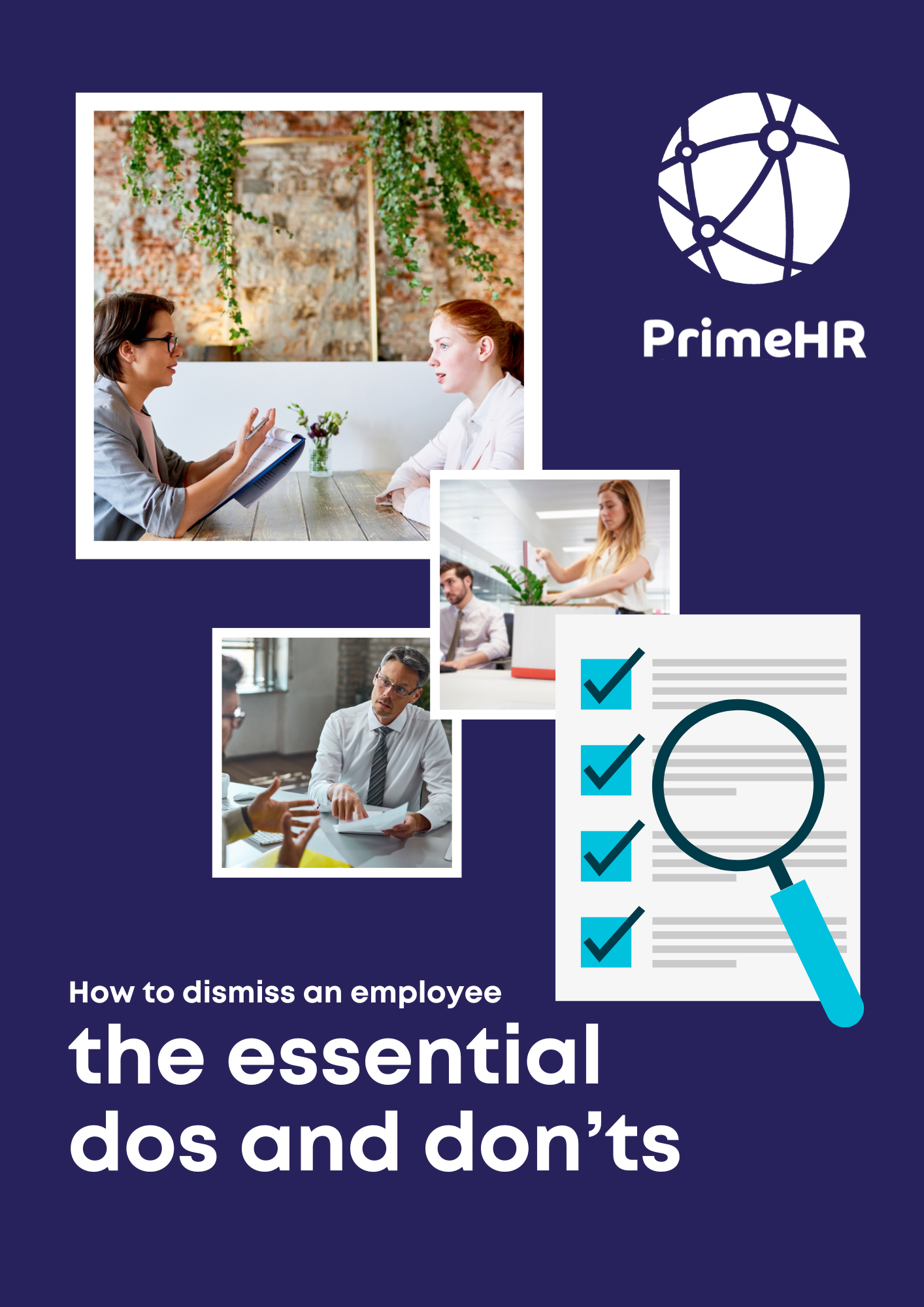Keep Up To Date
If you find our blog updates useful then consider subscribing to our newsletter for regular updates on UK Employment Law


Cookies
We require the use of cookies on our site to gather certain data to help us build our content. We also use cookies to assist in your user experience with some key functions and features of our system.
Our Policy
HOW TO DISMISS AN EMPLOYEE

THE ESSENTIAL DOS AND DON'TS
- Why Might You Want to Let an Employee Go?
- Disciplinary Procedure - Before You Begin
- The Process
- Think of Everyone Else
Running a business can be really stressful. Especially when you’ve got an employee that’s causing you lots of issues.
As an employer, it’s likely that at some point you might feel that it would be better for everybody to let an employee go.
And in some cases, this might be the right decision.
However, there are high risks involved when dismissing an employee. Which is why it’s absolutely essential that you have a valid reason to do so and that you follow a fair procedure every step of the way.
If you fail to do this, you risk a tribunal claim which will be even more stressful.
That’s why we've created this guide – to help you understand the steps you would take as an experienced HR expert to help you dismiss an employee.
But, make no mistake, if you are planning on dismissing an employee, this guide is no substitute for speaking and getting the advice of a legally qualified HR expert first.
If you find yourself in this position, please get in touch with us today.
Why Might You Want to Let an Employee Go?
There are so many reasons you may want to dismiss an employee for. Sadly, many of them simply won’t fly when it comes to abiding by employment law.
Before you take any action it’s always advisable to do your research and make sure you’re not discriminating against an employee, or acting in a way that could land you in an unfair dismissal case.
Some of the acceptable reasons may be:
• Someone is underperforming
• They’re not a good fit for the business
• They’re causing problems - this may be bullying, harassment, or discrimination, for example
• Not being able to do their job properly
• Violence, theft, vandalism (gross misconduct)
• Statutory restrictions - if a driver loses their licence, for example
Even in these cases there is still a process that you MUST follow before handing an employee their P45.
Disciplinary Procedure - Before You Begin
Unless you’re dealing with gross misconduct, it’s unlikely that you can jump straight to firing an employee.
First, you must follow your disciplinary procedure, as outlined in your own disciplinary policy, and give your employee warnings, as well as the opportunity to put things right (if applicable).
Never be tempted to rush this process. As much as you may want the employee out of the business, taking things too quickly can lead you straight to a tribunal.
As soon as you begin the process of dismissing an employee you should be taking notes and keeping a record of everything relating to that employee. This includes notes on their misconduct, performance, or other, and any evidence or investigation that you carry out to back up any allegations.
Written notes can be used as evidence that you’ve followed procedure correctly, and that you’ve carried out a fair process while trying to avoid dismissal.
If you can’t clearly prove the reason for dismissal, you may be accused of not acting fairly or not having a valid reason for your action.
Ask yourself: “Why do I need to fire this employee?”
If you can’t simply explain the reason and evidence why, it’s possible that your motivation is unfair or even discriminatory. It is absolutely vital that you’re not discriminating against any protected characteristics, such as age, religion, or gender. Again, such motivation could land you at a tribunal.
Remember, while employees with 2 or more years of continuous service have a legal right to challenge your decision to dismiss them, if the reason is discriminatory, anyone with any length of service can challenge you.
The Process
Once you’ve investigated and gathered any evidence you feel is necessary, you’ll need to decide if there is a case to answer. If so, then arrange a disciplinary meeting. This should be in private, away from other employees’ eyes and ears.
You must invite your employee to attend the meeting, in writing. A letter should inform them of the time and date of the meeting, advise them of their right to be accompanied, and it should also state that dismissal could be a potential outcome of the meeting.
Outline the reasons for the meeting and why dismissal is a consideration. You should also provide the evidence you have so that your employee has time to review it before the meeting.
When the meeting begins, it’s your job to explain the allegations to your employee. Be as detailed and specific as you can, go over the evidence from your investigation, and give them the opportunity to comment and respond to it all.
At this stage it’s very important to take notes. In fact, you should ideally have a note-taker present to allow you to give your full attention to the meeting. This person can also act as a witness on your behalf.
Expect there to be an emotional response from your employee. While this is normal, it’s important that you aren’t swayed by this and remain on track with your objectives. Have them written down in front of you as a memory aid if you think you might need it.
Once you’ve explained things to your employee and given them suitable opportunity to respond, you should adjourn the meeting. This is to give you adequate time to consider what they’ve told you and to make a final decision.
Explain what will happen to your employee and let them know how long it will take you to come to a decision. It could be later the same day, the next day, or even in a few days’ time. As long as you don’t have an unnecessary delay, while also giving yourself ample time to fully consider the situation. Of course, the complexity of the situation may also have bearing on how long your decision may take. Just make sure to keep your employee informed of when the outcome meeting will take place.
Remember, you will need to make a fair decision that is consistent with how you’ve acted in the past. If you’ve had a similar situation, it’s a good idea to look at how you dealt with that so that you don’t act unfairly.
You may find that, when it’s time for the outcome meeting, you still haven’t made a decision and you need additional time to gather more evidence or investigate further. That’s ok, but you need to communicate this with your employee as soon as possible and notify them of the new meeting.
Whatever your decision - to keep your employee or to dismiss them - you need to reiterate your reasoning and inform them of what is expected next. If you keep your employee this may involve a performance improvement plan or some training, for example.
Follow everything up in writing, and repeat what was discussed at the meeting. Remind your employee of their right to appeal the decision and the date that this must be done by. If you’re dismissing your employee, you’ll need to inform them of their last day of employment, pay arrangements including annual leave, and the return of any work property.
Think of Everyone Else
If you’re running a small business, it’s highly likely that someone being dismissed will have an impact on the team.
Once you’ve made your decision and informed the employee in question of the outcome, you should also let everyone else know what’s happening.
Without going into unnecessary detail, inform the team that their colleague will be leaving, and reassure them that it’s not a company issue, but an individual one. Explain that their jobs aren’t at risk, and if appropriate remind them of the consequences of serious behaviour and poor performance.
You may also wish to invite anyone to speak with you privately if they have any further concerns or questions.
Remember, it’s a stressful process, whether it’s the first time or the 10th. However, taking the right time to carefully plan your disciplinary process and meetings will help to ensure you take all the correct steps and don’t act unreasonably at any stage. Failing to act fairly or without discrimination can have serious consequences for your business, so prepare well and make sure the process is objectively conducted throughout.
If you’d like some expert guidance and advice, we’re always available to help. Just give us a call.
Dismissing an Employee
Your dos and don’ts checklist
DO...
• have a valid reason for wanting to dismiss an employee
• make sure you’re not discriminating against any protected characteristics
• follow your own disciplinary policy
• give your employee adequate warnings before dismissal
• keep a written record of everything
• sufficiently investigate before a disciplinary meeting
• keep your employee informed at each stage of the process
• give your employee sufficient opportunity to respond to allegations
• take reasonable time to consider the outcome
• follow everything up in writing
• keep other employees informed as appropriate
DON’T
• discriminate
• rush through the disciplinary process
• skip any steps
• forget to take notes and have a witness in your meetings
• be swayed by any emotional reactions
• be inconsistent with your decisions
• give other employees too much detail on the situation
• act alone if you’re unsure of the correct protocol or employment laws!